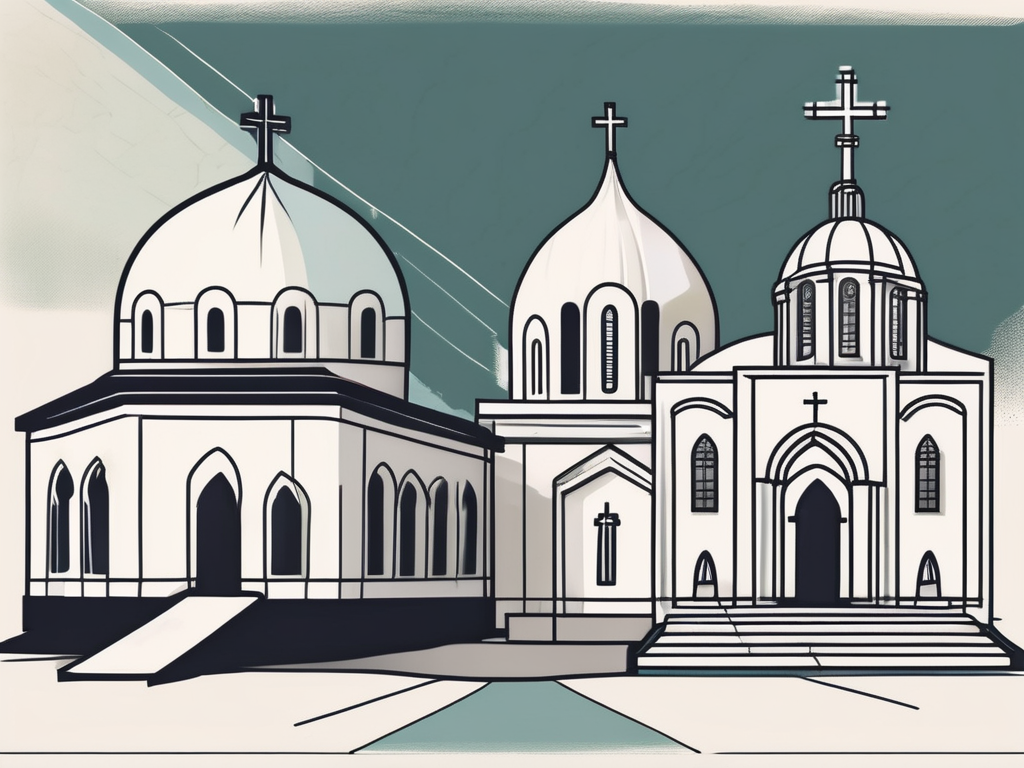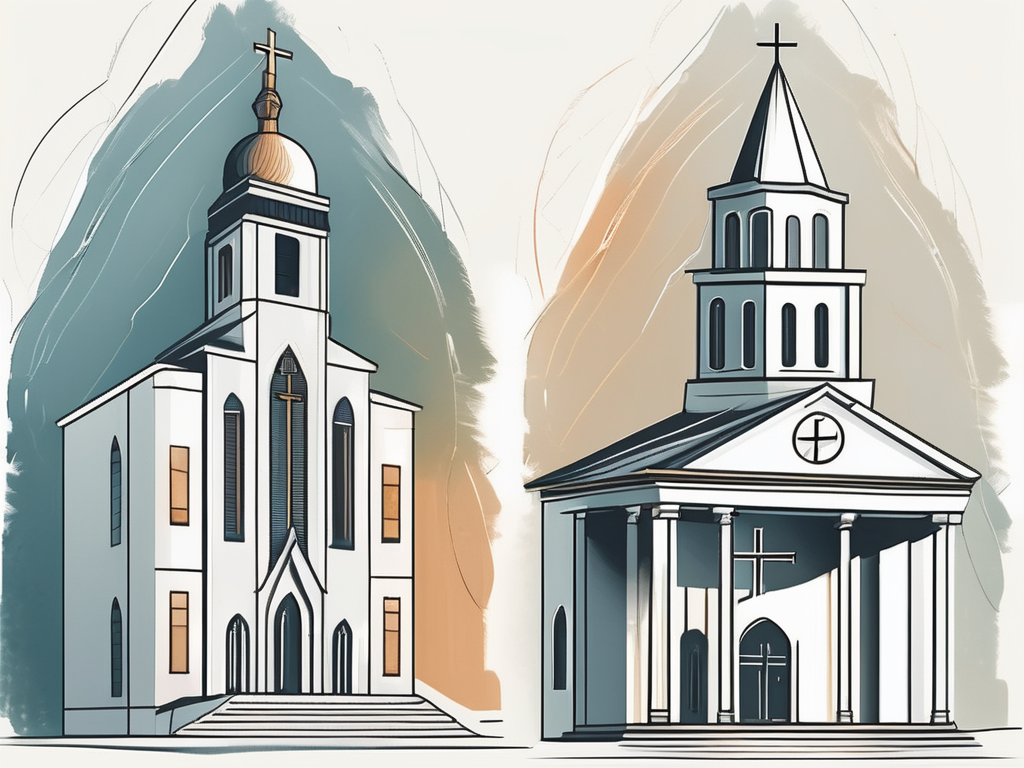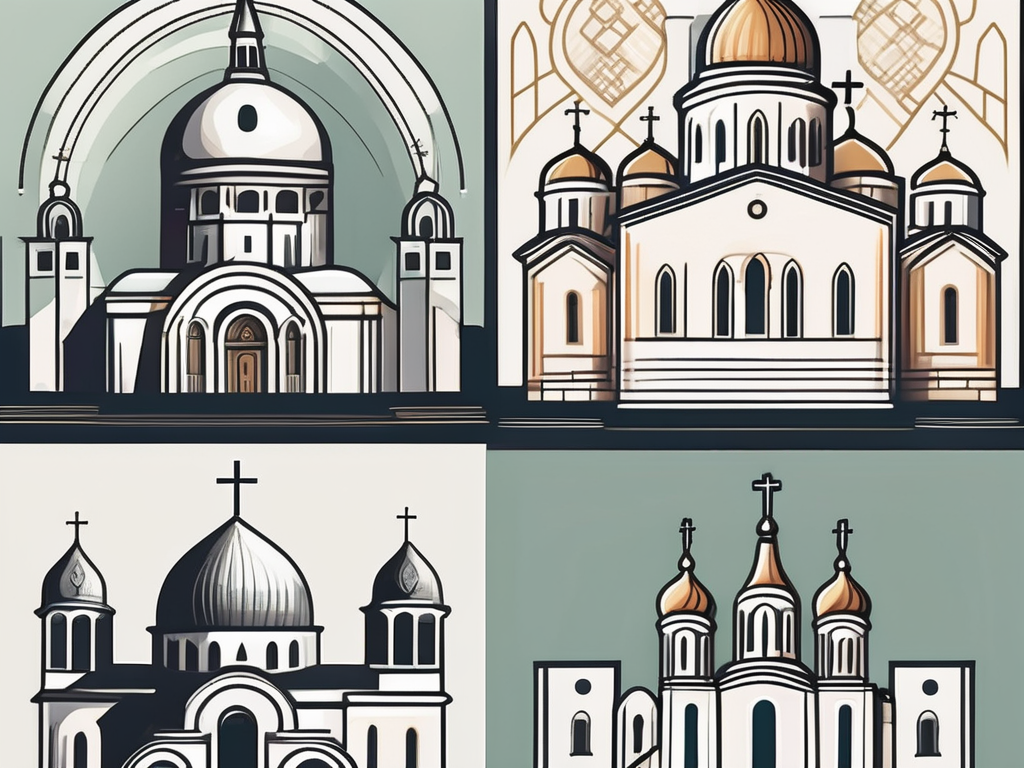Are you curious about the differences and similarities between the Eastern Orthodox and Baptist churches? These two Christian denominations have distinct histories, beliefs, and worship styles. In this article, we will delve into the fascinating world of these two faith traditions and explore what sets them apart, as well as what they have in common. So, let’s embark on this journey of discovery together!
Understanding the Eastern Orthodox Church
The Eastern Orthodox Church, also known as the Orthodox Church or simply Orthodoxy, traces its roots back to the early Christian communities established in the Byzantine Empire. It has a rich history that spans over two thousand years, dating back to the time of the Apostles.
The Eastern Orthodox Church played a significant role in the development of Christianity, particularly during the Byzantine Empire. It was during this time that the Church became a powerful institution, influencing not only religious matters but also political and cultural aspects of society. The Byzantine Empire’s capital, Constantinople, became the center of Orthodox Christianity, attracting scholars, theologians, and artists from all over the world.
Throughout its history, the Eastern Orthodox Church faced numerous challenges and underwent various transformations. The Great Schism in 1054 led to the separation of the Eastern Orthodox Church from the Roman Catholic Church, resulting in the establishment of distinct traditions and practices. This division had a lasting impact on the development of Christianity in both the East and the West.
Over the centuries, the Eastern Orthodox Church has been shaped by various historical events. The rise and fall of the Byzantine Empire, with its rich cultural heritage, left a lasting imprint on the Church. The invasions by the Ottoman Turks in the 15th century posed significant challenges to the Church’s survival, leading to the establishment of the Patriarchate of Moscow as a center of Orthodox Christianity.
Today, the Eastern Orthodox Church is one of the largest branches of Christianity, with millions of followers worldwide. It has a diverse and vibrant community, with different traditions and practices influenced by the various cultures and regions where Orthodoxy has taken root.
The History of the Eastern Orthodox Church
The Eastern Orthodox Church can trace its lineage back to the ancient Christian community in Byzantium, which later became known as Constantinople. The city’s strategic location, at the crossroads of Europe and Asia, played a crucial role in the spread of Christianity throughout the region.
During the early centuries of Christianity, Byzantium became a center of theological debates and intellectual pursuits. The Church Fathers, such as Basil the Great, Gregory of Nazianzus, and John Chrysostom, emerged from this vibrant intellectual environment, shaping the theological foundations of the Eastern Orthodox Church.
The Byzantine Empire’s close relationship with the Roman Empire allowed the Eastern Orthodox Church to exert its influence in the wider Christian world. The Councils of Nicaea in 325 and Constantinople in 381, both held in the Byzantine Empire, played a crucial role in defining the core beliefs and doctrines of Christianity.
Despite facing numerous challenges, including persecutions and internal divisions, the Eastern Orthodox Church persevered and continued to thrive. It became a beacon of faith and spirituality, attracting pilgrims and seekers of truth from all corners of the world.
Key Beliefs and Practices of the Eastern Orthodox Church
The Eastern Orthodox Church places great emphasis on tradition, both in terms of its doctrines and its liturgical practices. Central to its belief system is the notion of the “one, holy, catholic, and apostolic Church” as established by Jesus Christ.
Orthodox Christians also have a deep reverence for the Virgin Mary, whom they venerate as the Theotokos, or Mother of God. The Church’s devotion to Mary is expressed through prayers, hymns, and the use of icons depicting her and the life of Christ.
They believe in the mystery of the Eucharist, where bread and wine are consecrated and believed to become the actual body and blood of Christ. This sacrament is central to Orthodox worship and is celebrated with great reverence and awe.
Additionally, the Eastern Orthodox Church places great value on asceticism, prayer, and the pursuit of holiness. Monasticism has been an integral part of Orthodox Christianity since its early days, with monks and nuns dedicating their lives to prayer, contemplation, and service to others.
The worship services of the Eastern Orthodox Church are known for their beauty, solemnity, and use of icons and incense. The liturgy, with its intricate rituals and chants, aims to transport the worshipper into a transcendent encounter with the divine.
The Structure and Organization of the Eastern Orthodox Church
The Eastern Orthodox Church is headed by bishops, who are considered the successors of the Apostles. At the top of the hierarchy is the Ecumenical Patriarch, who holds a primacy of honor among the various autocephalous (self-governing) Orthodox churches.
Each local Orthodox Church is autonomous, with its own hierarchies governing its affairs. The Orthodox Church adheres to canons—ecclesiastical laws—that guide its structure and internal governance. These canons ensure the unity and coherence of the Church while allowing for diversity in local customs and practices.
The Eastern Orthodox Church has a rich tradition of synodical governance, where decisions are made collectively by bishops and other clergy. This conciliar approach ensures that major decisions are made in consultation with the wider Church, fostering a sense of unity and shared responsibility.
Throughout its history, the Eastern Orthodox Church has faced various challenges, including political interference, religious conflicts, and societal changes. However, it has remained resilient, adapting to new circumstances while holding steadfast to its core beliefs and traditions.
Delving into the Baptist Church
The Baptist Church, unlike the Eastern Orthodox Church, has a more recent historical origin. It emerged as a distinct sect within Protestantism during the 17th century in England.
The origins of the Baptist Church can be traced back to the early dissenting movements within the Church of England. Dissatisfied with the practices and teachings of the established church, individuals like John Smyth and Thomas Helwys sought to create a more authentic and personal religious experience. They rejected the practice of infant baptism, which was common in the Church of England, and instead advocated for adult baptism based on personal faith.
John Smyth, a former Anglican priest, is often credited with being the founder of the Baptist tradition. In 1609, he baptized himself and a small group of followers in Amsterdam, marking the beginning of the Baptist movement. Thomas Helwys, another key figure in Baptist history, later established the first Baptist church on English soil in 1612.
With time, Baptist beliefs spread beyond England to other parts of Europe and the Americas. The Baptist tradition found fertile ground among those seeking religious freedom and a more personal connection with God. Missionaries played a crucial role in spreading Baptist teachings, establishing churches, and translating religious texts into different languages.
Today, the Baptist Church is not a monolithic entity but rather comprises various denominations, each with its own unique traditions and interpretations of scripture. Some of the well-known Baptist denominations include the Southern Baptist Convention, American Baptist Churches USA, and the National Baptist Convention.
The History of the Baptist Church
The history of the Baptist Church is a fascinating journey filled with struggles, triumphs, and significant contributions to religious thought and practice. The early dissenters within the Church of England paved the way for a movement that would shape the religious landscape for centuries to come.
John Smyth and Thomas Helwys were not only pioneers of the Baptist tradition but also influential theologians. They challenged the prevailing religious norms of their time and championed the idea of individual freedom and responsibility in matters of faith. Their writings and teachings continue to inspire and guide Baptist believers to this day.
The Baptist movement faced persecution and opposition from both religious and political authorities. In England, Baptists were often viewed as radical dissenters and faced legal restrictions on their activities. Despite these challenges, the Baptist Church persevered and grew, attracting followers who valued its emphasis on personal faith and religious autonomy.
The Baptist tradition also played a significant role in the history of the United States. Many early American colonies were founded by individuals seeking religious freedom, and Baptists were among the groups that sought refuge in the New World. Their commitment to religious liberty and separation of church and state influenced the development of American democracy and the concept of religious freedom enshrined in the First Amendment of the United States Constitution.
Core Beliefs and Practices of the Baptist Church
At the core of Baptist beliefs is the principle of salvation through personal faith in Jesus Christ. Baptists emphasize the importance of a personal relationship with God and the transformative power of faith. They reject the notion that salvation can be achieved through rituals, sacraments, or the intercession of clergy.
Baptists practice “believer’s baptism,” which means that individuals are baptized as a public declaration of their faith. This practice symbolizes the believer’s identification with the death, burial, and resurrection of Jesus Christ. Baptism is seen as an act of obedience and a testimony of one’s personal faith in Christ.
Another key belief of Baptists is the authority of scripture. They view the Bible as the inspired word of God and the ultimate source of truth and guidance. Baptists encourage personal Bible study and interpretation, believing that every individual has the right and responsibility to understand and apply the teachings of the Bible in their own lives.
While Baptists share these core beliefs, there is diversity within the Baptist tradition. Different Baptist denominations may have variations in their practices and interpretations of scripture. Some may place more emphasis on certain aspects of faith, such as evangelism or social justice, while others may have different worship styles or organizational structures.
The Structure and Organization of the Baptist Church
The Baptist Church is characterized by its congregational polity, which means that each local church governs itself autonomously. There is no central governing body or hierarchy that dictates the practices and beliefs of all Baptist churches. This congregational autonomy is rooted in the belief in the priesthood of all believers, where every member of the church has equal access to God and the ability to contribute to the life and ministry of the church.
Despite the emphasis on congregational autonomy, many Baptist churches choose to voluntarily associate with larger organizations for fellowship, support, and collective decision-making. These associations or conventions provide a platform for churches to come together, share resources, and collaborate on missions and ministry efforts.
One prominent example of such an association is the Southern Baptist Convention (SBC), which represents the largest Baptist denomination in the United States. The SBC serves as a network of churches, providing support in areas such as missions, theological education, disaster relief, and social justice initiatives. While the SBC does not have direct control over individual churches, its influence and resources make it a significant force within the Baptist community.
Other Baptist denominations have their own organizational structures and networks. Some have regional or national conventions, while others may have associations based on shared theological beliefs or geographical proximity. These organizational structures vary in their level of authority and decision-making power, but they serve as a means for Baptist churches to connect, collaborate, and collectively address issues of common concern.
Comparing Eastern Orthodox and Baptist Beliefs
While the Eastern Orthodox and Baptist churches share a common Christian heritage, they have significant differences in their beliefs and practices. Let’s explore some of these key distinctions.
Views on Salvation
In the Eastern Orthodox Church, salvation is seen as a process of transformation and union with God. It involves synergy—cooperation between God’s grace and human effort. The sacraments, such as baptism and the Eucharist, play a crucial role in the journey towards salvation.
On the other hand, Baptists emphasize the individual’s personal relationship with Christ and the need for a conscious decision to accept Jesus as Lord and Savior. For them, salvation is a one-time event of being “born again” through faith in Christ alone.
Perspectives on the Holy Trinity
Both the Eastern Orthodox and Baptist churches hold to the doctrine of the Holy Trinity—the belief in one God consisting of Father, Son, and Holy Spirit. However, their understanding and emphasis may differ.
The Eastern Orthodox Church places great emphasis on the divine mystery of the Holy Trinity. They believe that the three persons of the Trinity are co-eternal and co-substantial, existing in perfect unity.
For Baptists, the Holy Trinity is also central to their faith, but they may place more focus on the individual’s personal relationship with Jesus Christ, who they believe to be God’s Son and the perfect revelation of God to humanity.
Understanding of the Sacraments
In the Eastern Orthodox Church, the sacraments are seen as tangible ways to experience God’s grace and participate in the mysteries of the faith. They have a rich sacramental tradition, including baptism, chrismation, the Eucharist, confession, and more.
For Baptists, the sacraments are viewed differently. They typically only recognize two sacraments—baptism and the Lord’s Supper. These symbolic acts commemorate Christ’s death, burial, and resurrection, but they are not believed to impart saving grace.
Contrasting Worship Styles and Practices
One of the most noticeable differences between the Eastern Orthodox and Baptist churches lies in their worship styles and practices.
Liturgical Traditions in the Eastern Orthodox Church
The Eastern Orthodox Church is known for its rich liturgical traditions, which are often characterized by beautiful chants, elaborate vestments, and the use of icons and incense.
Their worship services, called the Divine Liturgy, follow a defined structure and include various prayers, scripture readings, and hymns. Worshipers actively participate through responses, making the experience both communal and reverential.
Worship Practices in the Baptist Church
Baptist worship services, by contrast, are often less formal and more focused on preaching and congregational singing. They place a strong emphasis on the authority of scripture and strive for active individual engagement in worship.
Typically, Baptist worship services include prayer, congregational singing, scripture readings, and a sermon. The atmosphere may be more casual, allowing for greater spontaneity and personal expression of faith.
Conclusion
In conclusion, the Eastern Orthodox and Baptist churches represent two distinct branches of Christianity, each with its own rich history, beliefs, and worship practices. While they share a common love for Christ and the foundational tenets of Christianity, their differences in theology and worship styles are significant.
By exploring the differences and similarities between these two traditions, we gain a deeper understanding of the diverse expressions of the Christian faith. Whether you find resonance in the ancient traditions of the Eastern Orthodox Church or resonate with the autonomy and personal faith emphasized by the Baptist Church, both have compelling aspects that contribute to the tapestry of Christianity.
As we continue to explore the multifaceted world of faith, let us embrace the beauty and richness found within different Christian denominations, always seeking unity in Christ and celebrating the diversity that brings us together.












